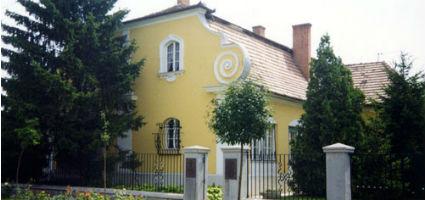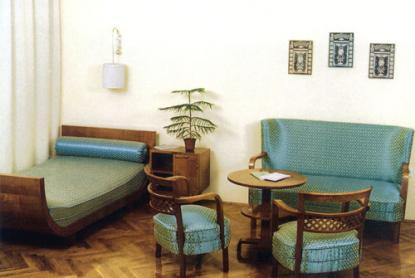2024. November 24. Sunday
Kner Printing Industry Museum - Gyomaendrőd
 |
Address: 5500, Gyomaendrőd Kossuth u. 16.
Phone number: (66) 581-640, (66) 887-445
E-mail: knermuzeum@gyomaikner.hu
Opening hours: 01.05-30.09.: Thu-Sun 10-16
|
Museum tickets, service costs:
|
Ticket for adults
|
700 HUF
|
|
|
Ticket for students
|
350 HUF
|
|
|
Ticket for pensioners
|
350 HUF
|
|
|
Guide
|
1500 HUF
|
From the second half of the 1920s Lajos Kozma's art can be characterised by the: effort crcate pure and practical fronl. According to him "this is a hath which requires that the artists should he sincere; they should devote all their energies to working on the material. Their creative power must beam with absolute certainty, which does not operate with ornaments borrowed form other places but throws their own soul into evenly single work of art." His interiors become lighter and lighter during his career; he uses enormous spaces witla little furniture which are made in a neutral style, and harmonize with their environment because of their cosiness.

The new set of furniture which was bought by the Kner Printing Industry Museum was made in 1928, fur Zsigmond Szegő, who used to be the director of the Electricity Works of Budapest, and, who put the furniturc into his flat in Rómer Flóris street. It was put into the girl's room, that is, into Anna Szegő s room, who was the daughter of the owner. The Szegő family bought the flat, which was also redecorated by Lajos Kozma, in the same year.
The floor of the girl's room was covered with silver-grey linoleum; the wallpaper on the walls was of a geometric pattern, and there was a fireplace covered with black and white, syuare-shaped tiles, which still can be seen in this flat the furniture is made of cherry-wood. To the beds, curtains with printed black and grey, and red and white, square-shaped patterns used to belong. Unfortunately, the furniture cover which was reps of special greenish-yellowish texture was ruined, and had to be replaced.
The Kner Museum came into the possession of the furnishings, a chandelier, and a wall lamp, which all used to belong to the same room. We must be aware that Kozrna was working on modern interior lamps for a long time, and designed a wide range of wall lamps and ceiling lights in 1928, which were manufactured by Jenő Grunberger's company. The lights in the flat of the Szegő family were also produced there.
The recent acquisitions of the Kner Museum in Gyoma - i.e. the furnishings of the girl's room which were designed for the colleague (and friend) of the Kner family, who (i.e. the Szegős) used to live in Homer Floris street - are of outstanding importance, and a nice rehresentative of the artist's (Kozmu's) career. Kozma was also well aware of it; therefore, he published this furniture in several Hungarian and foreign magazines. This interior marks a new era in his eareer: after the decline of the romantic, no baroque, entertaining style, the new interior is truly artistic, so mewl oriental, but above all biedermeider, and it is one of the most beautiful a harmonious manifestations of Art Deco in the field of handicrafts.

The new set of furniture which was bought by the Kner Printing Industry Museum was made in 1928, fur Zsigmond Szegő, who used to be the director of the Electricity Works of Budapest, and, who put the furniturc into his flat in Rómer Flóris street. It was put into the girl's room, that is, into Anna Szegő s room, who was the daughter of the owner. The Szegő family bought the flat, which was also redecorated by Lajos Kozma, in the same year.
The floor of the girl's room was covered with silver-grey linoleum; the wallpaper on the walls was of a geometric pattern, and there was a fireplace covered with black and white, syuare-shaped tiles, which still can be seen in this flat the furniture is made of cherry-wood. To the beds, curtains with printed black and grey, and red and white, square-shaped patterns used to belong. Unfortunately, the furniture cover which was reps of special greenish-yellowish texture was ruined, and had to be replaced.
The Kner Museum came into the possession of the furnishings, a chandelier, and a wall lamp, which all used to belong to the same room. We must be aware that Kozrna was working on modern interior lamps for a long time, and designed a wide range of wall lamps and ceiling lights in 1928, which were manufactured by Jenő Grunberger's company. The lights in the flat of the Szegő family were also produced there.
The recent acquisitions of the Kner Museum in Gyoma - i.e. the furnishings of the girl's room which were designed for the colleague (and friend) of the Kner family, who (i.e. the Szegős) used to live in Homer Floris street - are of outstanding importance, and a nice rehresentative of the artist's (Kozmu's) career. Kozma was also well aware of it; therefore, he published this furniture in several Hungarian and foreign magazines. This interior marks a new era in his eareer: after the decline of the romantic, no baroque, entertaining style, the new interior is truly artistic, so mewl oriental, but above all biedermeider, and it is one of the most beautiful a harmonious manifestations of Art Deco in the field of handicrafts.
